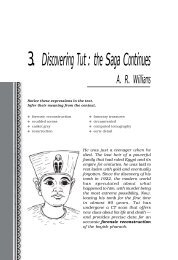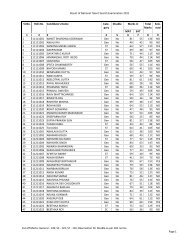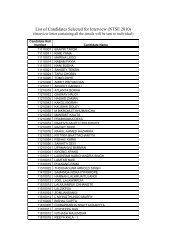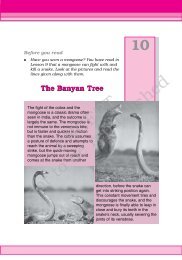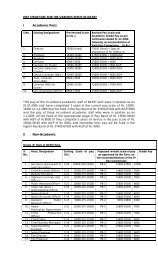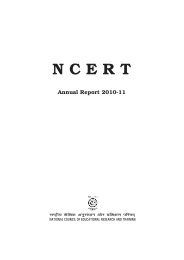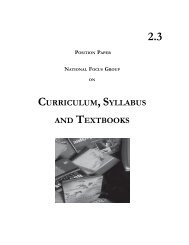PLANT KINGDOM
PLANT KINGDOM
PLANT KINGDOM
Create successful ePaper yourself
Turn your PDF publications into a flip-book with our unique Google optimized e-Paper software.
<strong>PLANT</strong> <strong>KINGDOM</strong> 29<br />
CHAPTER 3<br />
<strong>PLANT</strong> <strong>KINGDOM</strong><br />
3.1 Algae<br />
3.2 Bryophytes<br />
3.3 Pteridophytes<br />
3.4 Gymnosperms<br />
3.5 Angiosperms<br />
3.6 Plant Life Cycles<br />
and Alternation<br />
of Generations<br />
In the previous chapter, we looked at the broad classification of living<br />
organisms under the system proposed by Whittaker (1969) wherein he<br />
suggested the Five Kingdom classification viz. Monera, Protista, Fungi,<br />
Animalia and Plantae. In this chapter, we will deal in detail with further<br />
classification within Kingdom Plantae popularly known as the ‘plant<br />
kingdom’.<br />
We must stress here that our understanding of the plant kingdom<br />
has changed over time. Fungi, and members of the Monera and Protista<br />
having cell walls have now been excluded from Plantae though earlier<br />
classifications placed them in the same kingdom. So, the cyanobacteria<br />
that are also referred to as blue green algae are not ‘algae’ any more. In<br />
this chapter, we will describe Plantae under Algae, Bryophytes,<br />
Pteridophytes, Gymnosperms and Angiosperms.<br />
Let us also look at classification within angiosperms to understand<br />
some of the concerns that influenced the classification systems. The<br />
earliest systems of classification used only gross superficial morphological<br />
characters such as habit, colour, number and shape of leaves, etc. They<br />
were based mainly on vegetative characters or on the androecium<br />
structure (system given by Linnaeus). Such systems were artificial; they<br />
separated the closely related species since they were based on a few<br />
characteristics. Also, the artificial systems gave equal weightage to<br />
vegetative and sexual characteristics; this is not acceptable since we know<br />
that often the vegetative characters are more easily affected by<br />
environment. As against this, natural classification systems developed,<br />
which were based on natural affinities among the organisms and consider,
30 BIOLOGY<br />
not only the external features, but also internal features, like ultrastructure,<br />
anatomy, embryology and phytochemistry. Such a<br />
classification for flowering plants was given by George Bentham and<br />
Joseph Dalton Hooker.<br />
At present phylogenetic classification systems based on<br />
evolutionary relationships between the various organisms are acceptable.<br />
This assumes that organisms belonging to the same taxa have a common<br />
ancestor. We now use information from many other sources too to help<br />
resolve difficulties in classification. These become more important when<br />
there is no supporting fossil evidence. Numerical Taxonomy which is<br />
now easily carried out using computers is based on all observable<br />
characteristics. Number and codes are assigned to all the characters and<br />
the data are then processed. In this way each character is given equal<br />
importance and at the same time hundreds of characters can be<br />
considered. Cytotaxonomy that is based on cytological information like<br />
chromosome number, structure, behaviour and chemotaxonomy that<br />
uses the chemical constituents of the plant to resolve confusions, are also<br />
used by taxonomists these days.<br />
3.1 ALGAE<br />
Algae are chlorophyll-bearing, simple, thalloid, autotrophic and largely<br />
aquatic (both fresh water and marine) organisms. They occur in a variety<br />
of other habitats: moist stones, soils and wood. Some of them also occur<br />
in association with fungi (lichen) and animals (e.g., on sloth bear).<br />
The form and size of algae is highly variable (Figure 3.1). The size<br />
ranges from the microscopic unicellular forms like Chlamydomonas, to<br />
colonial forms like Volvox and to the filamentous forms like Ulothrix and<br />
Spirogyra. A few of the marine forms such as kelps, form massive plant<br />
bodies.<br />
The algae reproduce by vegetative, asexual and sexual methods.<br />
Vegetative reproduction is by fragmentation. Each fragment develops into<br />
a thallus. Asexual reproduction is by the production of different types of<br />
spores, the most common being the zoospores. They are flagellated<br />
(motile) and on germination gives rise to new plants. Sexual reproduction<br />
takes place through fusion of two gametes. These gametes can be<br />
flagellated and similar in size (as in Chlamydomonas) or non-flagellated<br />
(non-motile) but similar in size (as in Spirogyra). Such reproduction is<br />
called isogamous. Fusion of two gametes dissimilar in size, as in some<br />
species of Chlamydomonas is termed as anisogamous. Fusion between<br />
one large, non-motile (static) female gamete and a smaller, motile male<br />
gamete is termed oogamous, e.g., Volvox, Fucus.
<strong>PLANT</strong> <strong>KINGDOM</strong> 31<br />
Daughter<br />
colony<br />
Flagella<br />
Branches<br />
Parent<br />
colony<br />
Axis<br />
(a-i)<br />
(a-ii)<br />
(a-iii)<br />
Air bladder<br />
Frond<br />
Frond<br />
Midrib<br />
Frond<br />
(b-i)<br />
Stipe<br />
Holdfast<br />
(b-ii)<br />
Holdfast<br />
(b-iii)<br />
Stipe<br />
Frond<br />
Main axis<br />
Branches<br />
Figure 3.1 Algae :<br />
(c-i)<br />
(c-ii)<br />
(a) Green algae (i) Volvox (ii) Chlamydomonas (iii) Chara<br />
(b) Brown algae (i) Laminaria (ii) Fucus (iii) Dictyota<br />
(c) Red algae (i) Porphyra (ii) Polysiphonia
32 BIOLOGY<br />
Algae are useful to man in a variety of ways. At least a half of the total<br />
carbon dioxide fixation on earth is carried out by algae through<br />
photosynthesis. Being photosynthetic they increase the level of dissolved<br />
oxygen in their immediate environment. They are of paramount<br />
importance as primary producers of energy-rich compounds which form<br />
the basis of the food cycles of all aquatic animals. Many species of Porphyra,<br />
Laminaria and Sargassum are among the 70 species of marine algae<br />
used as food. Certain marine brown and red algae produce large amounts<br />
of hydrocolloids (water holding substances), e.g., algin (brown algae) and<br />
carrageen (red algae) which are used commercially. Agar, one of the<br />
commercial products obtained from Gelidium and Gracilaria are used to<br />
grow microbes and in preparations of ice-creams and jellies. Chlorella<br />
and Spirullina are unicellular algae, rich in proteins and are used as food<br />
supplements even by space travellers. The algae are divided into three<br />
main classes: Chlorophyceae, Phaeophyceae and Rhodophyceae.<br />
3.1.1 Chlorophyceae<br />
The members of chlorophyceae are commonly called green algae. The<br />
plant body may be unicellular, colonial or filamentous. They are usually<br />
grass green due to the dominance of pigments chlorophyll a and b. The<br />
pigments are localised in definite chloroplasts. The chloroplasts may be<br />
discoid, plate-like, reticulate, cup-shaped, spiral or ribbon-shaped in<br />
different species. Most of the members have one or more storage bodies<br />
called pyrenoids located in the chloroplasts. Pyrenoids contain protein<br />
besides starch. Some algae may store food in the form of oil droplets.<br />
Green algae usually have a rigid cell wall made of an inner layer of cellulose<br />
and an outer layer of pectose.<br />
Vegetative reproduction usually takes place by fragmentation or by<br />
formation of different types of spores. Asexual reproduction is by<br />
flagellated zoospores produced in zoosporangia. The sexual reproduction<br />
shows considerable variation in the type and formation of sex cells and it<br />
may be isogamous, anisogamous or oogamous. Some commonly found<br />
green algae are: Chlamydomonas, Volvox, Ulothrix, Spirogyra and Chara<br />
(Figure 3.1a).<br />
3.1.2 Phaeophyceae<br />
The members of phaeophyceae or brown algae are found primarily in<br />
marine habitats. They show great variation in size and form. They range<br />
from simple branched, filamentous forms (Ectocarpus) to profusely<br />
branched forms as represented by kelps, which may reach a height of<br />
100 metres. They possess chlorophyll a, c, carotenoids and xanthophylls.<br />
They vary in colour from olive green to various shades of brown depending<br />
upon the amount of the xanthophyll pigment, fucoxanthin present in
<strong>PLANT</strong> <strong>KINGDOM</strong> 33<br />
them. Food is stored as complex carbohydrates, which may be in the<br />
form of laminarin or mannitol. The vegetative cells have a cellulosic wall<br />
usually covered on the outside by a gelatinous coating of algin. The<br />
protoplast contains, in addition to plastids, a centrally located vacuole<br />
and nucleus. The plant body is usually attached to the substratum by a<br />
holdfast, and has a stalk, the stipe and leaf like photosynthetic organ –<br />
the frond. Vegetative reproduction takes place by fragmentation. Asexual<br />
reproduction in most brown algae is by biflagellate zoospores that are<br />
pear-shaped and have two unequal laterally attached flagella.<br />
Sexual reproduction may be isogamous, anisogamous or oogamous.<br />
Union of gametes may take place in water or within the oogonium<br />
(oogamous species). The gametes are pyriform (pear-shaped) and bear<br />
two laterally attached flagella. The common forms are Ectocarpus, Dictyota,<br />
Laminaria, Sargassum and Fucus (Figure 3.1b).<br />
3.1.3 Rhodophyceae<br />
The members of rhodophyceae are commonly called red algae because of<br />
the predominance of the red pigment, r-phycoerythrin in their body. Majority<br />
of the red algae are marine with greater concentrations found in the warmer<br />
areas. They occur in both well-lighted regions close to the surface of water<br />
and also at great depths in oceans where relatively little light penetrates.<br />
The red thalli of most of the red algae are multicellular. Some of them<br />
have complex body organisation. The food is stored as floridean starch<br />
which is very similar to amylopectin and glycogen in structure.<br />
The red algae usually reproduce vegetatively by fragmentation. They<br />
reproduce asexually by non-motile spores and sexually by non-motile<br />
TABLE 3.1 Divisions of Algae and their Main Characteristics<br />
Classes Common Major Stored Cell Wall Flagellar Habitat<br />
Name Pigments Food Number and<br />
Position of<br />
Insertions<br />
Chlorophyceae Green Chlorophyll Starch Cellulose 2-8, equal, Fresh water,<br />
algae a, b apical brackish water,<br />
salt water<br />
Phaeophyceae Brown Chlorophyll Mannitol, Cellulose 2, unequal, Fresh water<br />
algae a, c, laminarin and algin lateral (rare) brackish<br />
fucoxanthin<br />
water, salt<br />
water<br />
Rhodophyceae Red Chlorophyll Floridean Cellulose, Absent Fresh water<br />
algae a, d, starch pectin and (some),<br />
phycoerythrin poly brackish<br />
sulphate<br />
water, salt<br />
esters<br />
water (most)
34 BIOLOGY<br />
gametes. Sexual reproduction is oogamous and accompanied by complex<br />
post fertilisation developments. The common members are: Polysiphonia,<br />
Porphyra (Figure 3.1c), Gracilaria and Gelidium.<br />
3.2 BRYOPHYTES<br />
Bryophytes include the various mosses and liverworts that are found<br />
commonly growing in moist shaded areas in the hills (Figure 3.2).<br />
Archegoniophore<br />
Antheridiophore<br />
Gemma cup<br />
Gemma cup<br />
(a)<br />
Rhizoids<br />
(b)<br />
Rhizoids<br />
Capsule<br />
Antheridial<br />
branch<br />
Branches<br />
Sporophyte<br />
Seta<br />
Leaves<br />
Archegonial<br />
branch<br />
Gametophyte<br />
Main axis<br />
Rhizoids<br />
(c)<br />
(d)<br />
Figure 3.2<br />
Bryophytes: A liverwort – Marchantia (a) Female thallus (b) Male thallus<br />
Mosses – (c) Funaria, gametophyte and sporophyte (d) Sphagnum<br />
gametophyte
<strong>PLANT</strong> <strong>KINGDOM</strong> 35<br />
Bryophytes are also called amphibians of the plant kingdom because<br />
these plants can live in soil but are dependent on water for sexual<br />
reproduction. They usually occur in damp, humid and shaded localities.<br />
They play an important role in plant succession on bare rocks/soil.<br />
The plant body of bryophytes is more differentiated than that of algae.<br />
It is thallus-like and prostrate or erect, and attached to the substratum<br />
by unicellular or multicellular rhizoids. They lack true roots, stem or<br />
leaves. They may possess root-like, leaf-like or stem-like structures. The<br />
main plant body of the bryophyte is haploid. It produces gametes, hence<br />
is called a gametophyte. The sex organs in bryophytes are multicellular.<br />
The male sex organ is called antheridium. They produce biflagellate<br />
antherozoids. The female sex organ called archegonium is flask-shaped<br />
and produces a single egg. The antherozoids are released into water where<br />
they come in contact with archegonium. An antherozoid fuses with the<br />
egg to produce the zygote. Zygotes do not undergo reduction division<br />
immediately. They produce a multicellular body called a sporophyte.<br />
The sporophyte is not free-living but attached to the photosynthetic<br />
gametophyte and derives nourishment from it. Some cells of the<br />
sporophyte undergo reduction division (meiosis) to produce haploid<br />
spores. These spores germinate to produce gametophyte.<br />
Bryophytes in general are of little economic importance but some<br />
mosses provide food for herbaceous mammals, birds and other animals.<br />
Species of Sphagnum, a moss, provide peat that have long been used as<br />
fuel, and as packing material for trans-shipment of living material because<br />
of their capacity to hold water. Mosses along with lichens are the first<br />
organisms to colonise rocks and hence, are of great ecological importance.<br />
They decompose rocks making the substrate suitable for the growth of<br />
higher plants. Since mosses form dense mats on the soil, they reduce the<br />
impact of falling rain and prevent soil erosion. The bryophytes are divided<br />
into liverworts and mosses.<br />
3.2.1 Liverworts<br />
The liverworts grow usually in moist, shady habitats such as banks of<br />
streams, marshy ground, damp soil, bark of trees and deep in the woods.<br />
The plant body of a liverwort is thalloid, e.g., Marchantia. The thallus is<br />
dorsiventral and closely appressed to the substrate. The leafy members<br />
have tiny leaf-like appendages in two rows on the stem-like structures.<br />
Asexual reproduction in liverworts takes place by fragmentation of<br />
thalli, or by the formation of specialised structures called gemmae<br />
(sing. gemma). Gemmae are green, multicellular, asexual buds, which<br />
develop in small receptacles called gemma cups located on the thalli.<br />
The gemmae become detached from the parent body and germinate to<br />
form new individuals. During sexual reproduction, male and female sex
36 BIOLOGY<br />
organs are produced either on the same or on different thalli. The<br />
sporophyte is differentiated into a foot, seta and capsule. After meiosis,<br />
spores are produced within the capsule. These spores germinate to form<br />
free-living gametophytes.<br />
3.2.2 Mosses<br />
The predominant stage of the life cycle of a moss is the gametophyte which<br />
consists of two stages. The first stage is the protonema stage, which<br />
develops directly from a spore. It is a creeping, green, branched and<br />
frequently filamentous stage. The second stage is the leafy stage, which<br />
develops from the secondary protonema as a lateral bud. They consist of<br />
upright, slender axes bearing spirally arranged leaves. They are attached<br />
to the soil through multicellular and branched rhizoids. This stage bears<br />
the sex organs.<br />
Vegetative reproduction in mosses is by fragmentation and budding<br />
in the secondary protonema. In sexual reproduction, the sex organs<br />
antheridia and archegonia are produced at the apex of the leafy shoots.<br />
After fertilisation, the zygote develops into a sporophyte, consisting of a<br />
foot, seta and capsule. The sporophyte in mosses is more elaborate than<br />
that in liverworts. The capsule contains spores. Spores are formed after<br />
meiosis. The mosses have an elaborate mechanism of spore dispersal.<br />
Common examples of mosses are Funaria, Polytrichum and Sphagnum<br />
(Figure 3.2).<br />
3.3 PTERIDOPHYTES<br />
The Pteridophytes include horsetails and ferns. Pteridophytes are used<br />
for medicinal purposes and as soil-binders. They are also frequently grown<br />
as ornamentals. Evolutionarily, they are the first terrestrial plants to<br />
possess vascular tissues – xylem and phloem. You shall study more about<br />
these tissues in Chapter 6. The pteridophytes are found in cool, damp,<br />
shady places though some may flourish well in sandy-soil conditions.<br />
You may recall that in bryophytes the dominant phase in the life<br />
cycle is the gametophytic plant body. However, in pteridophytes, the<br />
main plant body is a sporophyte which is differentiated into true root,<br />
stem and leaves (Figure 3.3). These organs possess well-differentiated<br />
vascular tissues. The leaves in pteridophyta are small (microphylls) as<br />
in Selaginella or large (macrophylls) as in ferns. The sporophytes bear<br />
sporangia that are subtended by leaf-like appendages called<br />
sporophylls. In some cases sporophylls may form distinct compact<br />
structures called strobili or cones (Selaginella, Equisetum). The<br />
sporangia produce spores by meiosis in spore mother cells. The spores<br />
germinate to give rise to inconspicuous, small but multicellular,
<strong>PLANT</strong> <strong>KINGDOM</strong> 37<br />
Strobilus<br />
Node<br />
Internode<br />
Branch<br />
Rhizome<br />
(b)<br />
(c)<br />
(d)<br />
Figure 3.3 Pteridophytes : (a) Selaginella (b) Equisetum (c) Fern (d) Salvinia
38 BIOLOGY<br />
free-living, mostly photosynthetic thalloid gametophytes called<br />
prothallus. These gametophytes require cool, damp, shady places to<br />
grow. Because of this specific restricted requirement and the need for<br />
water for fertilisation, the spread of living pteridophytes is limited and<br />
restricted to narrow geographical regions. The gametophytes bear male<br />
and female sex organs called antheridia and archegonia, respectively.<br />
Water is required for transfer of antherozoids – the male gametes released<br />
from the antheridia, to the mouth of archegonium. Fusion of male gamete<br />
with the egg present in the archegonium result in the formation of zygote.<br />
Zygote thereafter produces a multicellular well-differentiated sporophyte<br />
which is the dominant phase of the pteridophytes. In majority of the<br />
pteridophytes all the spores are of similar kinds; such plants are called<br />
homosporous. Genera like Selaginella and Salvinia which produce<br />
two kinds of spores, macro (large) and micro (small) spores, are known<br />
as heterosporous. The megaspores and microspores germinate and give<br />
rise to female and male gametophytes, respectively. The female<br />
gametophytes in these plants are retained on the parent sporophytes<br />
for variable periods. The development of the zygotes into young embryos<br />
take place within the female gametophytes. This event is a precursor to<br />
the seed habit considered an important step in evolution.<br />
The pteridophytes are further classified into four classes: Psilopsida<br />
(Psilotum); Lycopsida (Selaginella, Lycopodium), Sphenopsida (Equisetum)<br />
and Pteropsida (Dryopteris, Pteris, Adiantum).<br />
3.4 GYMNOSPERMS<br />
The gymnosperms (gymnos : naked, sperma : seeds) are plants in which<br />
the ovules are not enclosed by any ovary wall and remain exposed, both<br />
before and after fertilisation. The seeds that develop post-fertilisation, are<br />
not covered, i.e., are naked. Gymnosperms include medium-sized trees<br />
or tall trees and shrubs (Figure 3.4). One of the gymnosperms, the giant<br />
redwood tree Sequoia is one of the tallest tree species. The roots are<br />
generally tap roots. Roots in some genera have fungal association in the<br />
form of mycorrhiza (Pinus), while in some others (Cycas) small specialised<br />
roots called coralloid roots are associated with N 2<br />
- fixing cyanobacteria.<br />
The stems are unbranched (Cycas) or branched (Pinus, Cedrus). The leaves<br />
may be simple or compound. In Cycas the pinnate leaves persist for a few<br />
years. The leaves in gymnosperms are well-adapted to withstand extremes<br />
of temperature, humidity and wind. In conifers, the needle-like leaves<br />
reduce the surface area. Their thick cuticle and sunken stomata also<br />
help to reduce water loss.
<strong>PLANT</strong> <strong>KINGDOM</strong> 39<br />
The gymnosperms are heterosporous; they produce<br />
haploid microspores and megaspores. The two kinds of<br />
spores are produced within sporangia that are borne on<br />
sporophylls which are arranged spirally along an axis to<br />
form lax or compact strobili or cones. The strobili bearing<br />
microsporophylls and microsporangia are called<br />
microsporangiate or male strobili. The microspores<br />
develop into a male gametophytic generation which is<br />
highly reduced and is confined to only a limited number<br />
of cells. This reduced gametophyte is called a pollen<br />
grain. The development of pollen grains take place within<br />
the microsporangia. The cones bearing megasporophylls<br />
with ovules or megasporangia are called<br />
macrosporangiate or female strobili. The male or female<br />
cones or strobili may be borne on the same tree (Pinus).<br />
However, in cycas male cones and megasporophylls are<br />
borne on different trees. The megaspore mother cell is<br />
differentiated from one of the cells of the nucellus. The<br />
nucellus is protected by envelopes and the composite<br />
structure is called an ovule. The ovules are borne on<br />
megasporophylls which may be clustered to form the<br />
female cones. The megaspore mother cell divides<br />
meiotically to form four megaspores. One of the<br />
megaspores enclosed within the megasporangium<br />
(nucellus) develops into a multicellular female<br />
gametophyte that bears two or more archegonia or female<br />
sex organs. The multicellular female gametophyte is also<br />
retained within megasporangium.<br />
Unlike bryophytes and pteridophytes, in<br />
gymnosperms the male and the female gametophytes<br />
do not have an independent free-living existence. They<br />
remain within the sporangia retained on the<br />
sporophytes. The pollen grain is released from the<br />
microsporangium. They are carried in air currents and<br />
come in contact with the opening of the ovules borne<br />
on megasporophylls. The pollen tube carrying the male<br />
gametes grows towards archegonia in the ovules and<br />
discharge their contents near the mouth of the<br />
archegonia. Following fertilisation, zygote develops into<br />
an embryo and the ovules into seeds. These seeds are<br />
not covered.<br />
Dwarf Shoot<br />
Long Shoot<br />
Seeds<br />
(a)<br />
(b)<br />
Long<br />
shoot<br />
Dwarf<br />
shoot<br />
Seeds<br />
(c)<br />
Figure 3.4 Gymnosperms: (a) Cycas<br />
(b) Pinus (c) Ginkgo
40 BIOLOGY<br />
3.5 ANGIOSPERMS<br />
Unlike the gymnosperms where the ovules are naked, in the angiosperms<br />
or flowering plants, the pollen grains and ovules are developed in specialised<br />
structures called flowers. In angiosperms, the seeds are enclosed by fruits.<br />
The angiosperms are an exceptionally large group of plants occurring in<br />
wide range of habitats. They range in size from tiny, almost microscopic<br />
Wolfia to tall trees of Eucalyptus (over 100 metres). They provide us with<br />
food, fodder, fuel, medicines and several other commercially important<br />
products. They are divided into two classes : the dicotyledons and the<br />
monocotyledons (Figure 3.5). The dicotyledons are characterised by<br />
having two cotyledons in their seeds while the monocolyledons have only<br />
one. The male sex organ in a flower is the stamen. Each stamen consists of<br />
a slender filament with an anther at the tip. The anthers, following meiosis,<br />
produce pollen grains. The female sex organ in a flower is the pistil or the<br />
carpel. Pistil consists of an ovary enclosing one to many ovules. Within<br />
ovules are present highly reduced female gametophytes termed embryosacs.<br />
The embryo-sac formation is preceded by meiosis. Hence, each of the<br />
cells of an embryo-sac is haploid. Each embryo-sac has a three-celled egg<br />
apparatus – one egg cell and two synergids, three antipodal cells and<br />
two polar nuclei. The polar nuclei eventually fuse to produce a diploid<br />
secondary nucleus. Pollen grain, after dispersal from the anthers, are carried<br />
by wind or various other agencies to the stigma of a pistil. This is termed as<br />
(a)<br />
Figure 3.5 Angiosperms : (a) A dicotyledon (b) A monocotyledon<br />
(b)
<strong>PLANT</strong> <strong>KINGDOM</strong> 41<br />
pollination. The pollen grains germinate on the stigma and the resulting<br />
pollen tubes grow through the tissues of stigma and style and reach the<br />
ovule. The pollen tubes enter the embryo-sac where two male gametes are<br />
discharged. One of the male gametes fuses with the egg cell to form a zygote<br />
(syngamy). The other male gamete fuses with the diploid secondary nucleus<br />
to produce the triploid primary endosperm nucleus (PEN). Because of the<br />
involvement of two fusions, this event is termed as double fertilisation,<br />
an event unique to angiosperms. The zygote develops into an embryo (with<br />
one or two cotyledons) and the PEN develops into endosperm which provides<br />
nourishment to the developing embryo. The synergids and antipodals<br />
degenerate after fertilisation. During these events the ovules develop into<br />
seeds and the ovaries develop into fruit. The life cycle of an angiosperm is<br />
shown in Figure 3.6.<br />
Figure 3.6 Life cycle of an angiosperm
42 BIOLOGY<br />
Zygote<br />
(2n)<br />
Meiosis<br />
3.6 <strong>PLANT</strong> LIFE CYCLES AND ALTERNATION OF<br />
GENERATIONS<br />
Syngamy<br />
Gametogenesis<br />
A<br />
Haplontic<br />
Gametophyte<br />
(n)<br />
B<br />
Spores<br />
(n)<br />
(a)<br />
In plants, both haploid and diploid cells can divide by<br />
mitosis. This ability leads to the formation of different<br />
plant bodies - haploid and diploid. The haploid plant<br />
body produces gametes by mitosis. This plant body<br />
represents a gametophyte. Following fertilisation the<br />
zygote also divides by mitosis to produce a diploid<br />
sporophytic plant body. Haploid spores are produced<br />
by this plant body by meiosis. These in turn, divide by<br />
mitosis to form a haploid plant body once again. Thus,<br />
during the life cycle of any sexually reproducing plant,<br />
there is an alternation of generations between gamete<br />
producing haploid gametophyte and spore producing<br />
diploid sporophyte.<br />
However, different plant groups, as well as individuals<br />
representing them, differ in the following patterns:<br />
Zygote<br />
(2n)<br />
Syngamy<br />
Sporophyte<br />
(2n)<br />
A<br />
1. Sporophytic generation is represented only by the<br />
one-celled zygote. There are no free-living<br />
sporophytes. Meiosis in the zygote results in the<br />
formation of haploid spores. The haploid spores<br />
divide mitotically and form the gametophyte. The<br />
dominant, photosynthetic phase in such plants is<br />
the free-living gametophyte. This kind of life cycle<br />
is termed as haplontic. Many algae such as Volvox,<br />
Spirogyra and some species of Chlamydomonas<br />
represent this pattern (Figure 3.7 a).<br />
2. On the other extreme, is the type wherein the diploid<br />
sporophyte is the dominant, photosynthetic,<br />
independent phase of the plant. The gametophytic<br />
Gametogenesis<br />
Haplo-diplontic<br />
B<br />
Spores<br />
(n)<br />
Meiosis<br />
phase is represented by the single to few-celled<br />
haploid gametophyte. This kind of life cycle is<br />
termed as diplontic. All seed-bearing plants i.e.<br />
gymnosperms and angiosperms, follow this pattern<br />
(Figure 3.7 b).<br />
Gametophyte<br />
(n)<br />
Figure 3.7 Life cycle patterns : (a) Haplontic<br />
(b) Diplontic (c) Haplo-diplontic<br />
(c)<br />
3. Bryophytes and pteridophytes, interestingly, exhibit<br />
an intermediate condition (Haplo-diplontic); both<br />
phases are multicellular. However, they differ in their<br />
dominant phases.
<strong>PLANT</strong> <strong>KINGDOM</strong> 43<br />
A dominant, independent, photosynthetic, thalloid or erect phase is<br />
represented by a haploid gametophyte and it alternates with the shortlived<br />
multicelluler sporophyte totally or partially dependent on the<br />
gametophyte for its anchorage and nutrition. All bryophytes represent<br />
this pattern.<br />
The diploid sporophyte is represented by a dominant, independent,<br />
photosynthetic, vascular plant body. It alternates with multicellular,<br />
saprophytic/autotrophic, independent but short-lived haploid<br />
gametophyte. Such a pattern is known as haplo-diplontic life cycle. All<br />
pteridophytes exhibit this pattern (Figure 3.7 c).<br />
Interestingly, while most algal genera are haplontic, some of them<br />
such as Ectocarpus, Polysiphonia, kelps are haplo-diplontic. Fucus, an<br />
alga is diplontic.<br />
SUMMARY<br />
Plant kingdom includes algae, bryophytes, pteridophytes, gymnosperms and<br />
angiosperms. Algae are chlorophyll-bearing simple, thalloid, autotrophic and<br />
largely aquatic organisms. Depending on the type of pigment possesed and the<br />
type of stored food, algae are classfied into three classes, namely Chlorophyceae,<br />
Phaeophyceae and Rhodophyceae. Algae usually reproduce vegetatively by<br />
fragmentation, asexually by formation of different types of spores and sexually by<br />
formation of gametes which may show isogamy, anisogamy or oogamy.<br />
Bryophytes are plants which can live in soil but are dependent on water for<br />
sexual reproduction. Their plant body is more differentiated than that of algae. It<br />
is thallus-like and prostrate or erect and attached to the substratum by rhizoids.<br />
They possess root-like, leaf-like and stem-like structures. The bryophytes are<br />
divided into liverworts and mosses. The plant body of liverworts is thalloid and<br />
dorsiventral whereas mosses have upright, slender axes bearing spirally arranged<br />
leaves. The main plant body of a bryophyte is gamete-producing and is called a<br />
gametophyte. It bears the male sex organs called antheridia and female sex organs<br />
called archegonia. The male and female gametes produced fuse to form zygote<br />
which produces a multicellular body called a sporophyte. It produces haploid<br />
spores. The spores germinate to form gametophytes.<br />
In pteridophytes the main plant is a sporophyte which is differentiated into<br />
true root, stem and leaves. These organs possess well-differentiated vascular<br />
tissues. The sporophytes bear sporangia which produce spores. The spores<br />
germinate to form gametophytes which require cool, damp places to grow. The<br />
gametophytes bear male and female sex organs called antheridia and archegonia,<br />
respectively. Water is required for transfer of male gametes to archegonium where<br />
zygote is formed after fertilisation. The zygote produces a sporophyte.
44 BIOLOGY<br />
The gymnosperms are the plants in which ovules are not enclosed by any<br />
ovary wall. After fertilisation the seeds remain exposed and therefore these plants<br />
are called naked-seeded plants. The gymnosperms produce microspores and<br />
megaspores which are produced in microsporangia and megasporangia borne on<br />
the sporophylls. The sporophylls – microsporophylls and megasporophylls – are<br />
arranged spirally on axis to form male and female cones, respectively. The pollen<br />
grain germinates and pollen tube releases the male gamete into the ovule, where it<br />
fuses with the egg cell in archegonia. Following fertilisation, the zygote develops<br />
into embryo and the ovules into seeds.<br />
In angiosperms, the male sex organs (stamen) and female sex organs (pistil)<br />
are borne in a flower. Each stamen consists of a filament and an anther. The anther<br />
produces pollen grains (male gametophyte) after meiosis. The pistil consists of an<br />
ovary enclosing one to many ovules. Within the ovule is the female gametophyte<br />
or embryo sac which contains the egg cell. The pollen tube enters the embryo-sac<br />
where two male gametes are discharged. One male gamete fuses with egg cell<br />
(syngamy) and other fuses with diploid secondary nucleus (triple fusion). This<br />
phenomenon of two fusions is called double fertilisation and is unique to<br />
angiosperms. The angiosperms are divided into two classes – the dicotyledons<br />
and the monocotyledons.<br />
During the life cycle of any sexually reproducing plant, there is alternation of<br />
generations between gamete producing haploid gametophyte and spore producing<br />
diploid sporophyte. However, different plant groups as well as individuals may<br />
show different patterns of life cycles – haplontic, diplontic or intermediate.<br />
EXERCISES<br />
1. What is the basis of classification of algae?<br />
2. When and where does reduction division take place in the life cycle of a liverwort,<br />
a moss, a fern, a gymnosperm and an angiosperm?<br />
3. Name three groups of plants that bear archegonia. Briefly describe the life cycle<br />
of any one of them.<br />
4. Mention the ploidy of the following: protonemal cell of a moss; primary endosperm<br />
nucleus in dicot, leaf cell of a moss; prothallus cell of a ferm; gemma cell in<br />
Marchantia; meristem cell of monocot, ovum of a liverwort, and zygote of a fern.<br />
5. Write a note on economic importance of algae and gymnosperms.<br />
6. Both gymnosperms and angiosperms bear seeds, then why are they classified<br />
separately?<br />
7. What is heterospory? Briefly comment on its significance. Give two examples.
<strong>PLANT</strong> <strong>KINGDOM</strong> 45<br />
8. Explain briefly the following terms with suitable examples:-<br />
(i) protonema<br />
(ii) antheridium<br />
(iii) archegonium<br />
(iv) diplontic<br />
(v) sporophyll<br />
(vi) isogamy<br />
9. Differentiate between the following:-<br />
(i) red algae and brown algae<br />
(ii) liverworts and moss<br />
(iii) homosporous and heterosporous pteridophyte<br />
(iv) syngamy and triple fusion<br />
10. How would you distinguish monocots from dicots?<br />
11. Match the following (column I with column II)<br />
Column I<br />
Column II<br />
(a) Chlamydomonas<br />
(i) Moss<br />
(b) Cycas<br />
(ii) Pteridophyte<br />
(c) Selaginella<br />
(iii) Algae<br />
(d) Sphagnum<br />
(iv) Gymnosperm<br />
12. Describe the important characteristics of gymnosperms.




